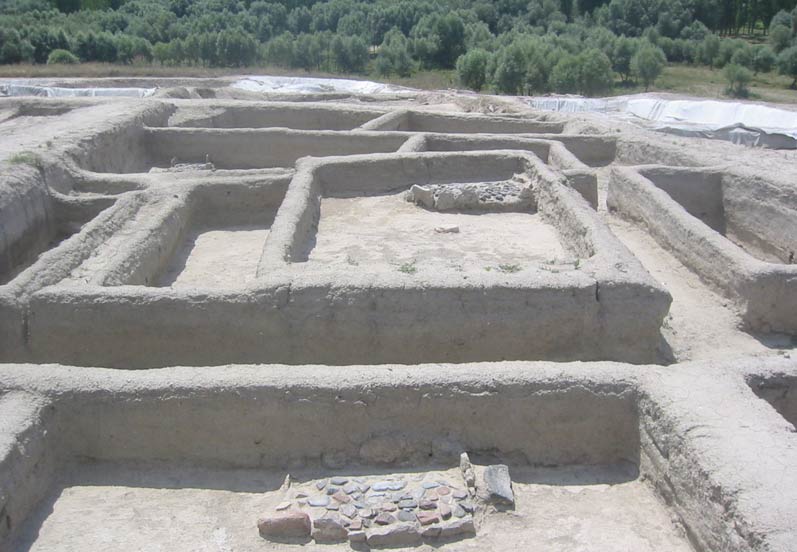11,000-year-old site of Asikli Hoyuk in Turkey reveals early brain surgery and ancient craftsmanship
The ancient Neolithic settlement of Asikli Hoyuk (Aşıklı Höyük) boasts many important discoveries. Excavations have revealed crucial information on the history of brain surgery, early mining, astounding craftsmanship, and human transitions from nomadic to sedentary lifestyles. Yet Asikli Hoyuk, found 25 kilometers southeast of Aksaray, Turkey, is often overshadowed by popular sites like Göbekli Tepe.
Nevertheless, the site continues to astound archaeologists and visitors alike as it reveals the secrets of the original inhabitants dating back to 9000 B.C., even after 25 years of modern excavation.

Example of the semi-subterranean oval-shaped huts found at Aşıklı Höyük, Turkey (Hurriyet Daily News)
Professor Mihriban Özbaşaran of İstanbul University, head of the research project at Asikli Hoyuk, has continued the excavations which began in 1989. According to Hurriyet Daily News, the major importance of the site is the role it played in the history of the region as early hunters and gatherers shifted from nomadic lifestyles to more permanent villages. They began producing their own goods with techniques that we still don’t fully understand today. Özbaşaran told Hurriyet Daily News, “Before, they were in small groups on the move. Here is the first time they started to be together for 24 hours as a community.” It was then that animal domestication, manufacturing and construction developed due to interaction with other populations.
Asikli Hoyuk was located near an obsidian source, and became a base of trade which stretched to modern day Cyprus and Iraq. Wikipedia notes that some 6,000 obsidian objects were retrieved from the surface layer of the site. This count eventually included fragments of a unique obsidian bracelet, significant due to its age and the high level of craftsmanship involved. The glossy piece, made of obsidian – a very hard volcanic glass - required highly specialized techniques, and experts still do not know how it was accomplished.
“Using high-tech methods developed by LTDS [Laboratoire de Tribologie et de Dynamiques des Systèmes] to study the bracelet's surface and its micro-topographic features, the researchers have revealed the astounding technical expertise of craftsmen in the eighth millennium BC. Their skills were highly sophisticated for this period in late prehistory, and on a par with today's polishing techniques,” reports Archaeology News Network.

Oldest obsidian bracelet ever identified, Asikli Hoyuk, Turkey. (Source)
Remains have been found at the site, revealing many things about the ancient inhabitants. Several skeletons were located buried beneath houses, including many children, younger women and older men. Men seemed to live into their 50’s, while women frequently died much earlier, in their 20’s and 30’s. However, researchers provide no firm conclusions as to why men might have outlived the women in the settlement, nor whether burial style represented status. “Looking at the way they lived and burial rituals, we could not find any sign that would suggest the presence of a hierarchy in the community. We can’t discern a ruling class for instance,” Professor Özbaşaran told Hurriyet Daily News.
Archaeolgoists found skulls at Asikli Hoyuk demonstrating the earliest-known brain surgery. Trepanation, or drilling holes into the skull in an attempt to relieve or cure ailments or mental illness, has been found on skulls at the site.

Burial at Aşıklı Höyük of remains in a fetal (hocker) position, arms embracing the legs. S. Murray (Wikipedia)
Excavations continue, and archaeologists suggest that the work and discoveries will continue for another 25 years in this location so full of history.
Researchers at Asikli Hoyuk have created streets and full-size replica houses, examples of the traditional semi-subterranean, mud-brick architecture, with the intention of creating an open air museum. This is hoped to bring humanity’s past into perspective, and give a glimpse into the lives and beliefs of Neolithic man during an era of transition.

Inside a reconstructed building at Asikli Hoyuk. Kvaestad (Public Domain)
Featured Image: Excavations of the Neolithic site of Asikli Hoyuk. Katpatuka (Wikipedia)
By Liz Leafloor



















Comments
I suggest one possible cause of the difference between the longevity of men vs women, not onlhy in Asikli Hoyuk but in the world in general...
In 1900, the average age of a man's longevity was 50 years of age, barring living past the ripe old age of 10, by which time 6 out of 10 male and females died due to chldhood diseases and illnesses, and this 50-year old man would have had 4 wives if he made it to 50 years of age; two of the his wives dying at a young age due to childbirth problems (a doctor delivering a calf next door, then coming to the assistance of a pregnent female without sanitizing his hands, complications with the childbrith itself, or sepsis or bleeding to death after delivery)...so it shouldn't be too much pof a stretch of our imaginations to assume that these same causes affected the women of Asikli Hoyuk as well.
Trepanation is not brain-surgery.